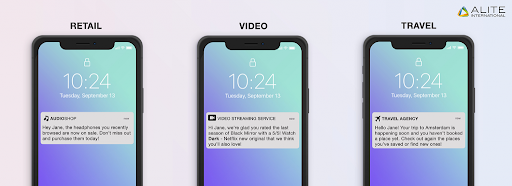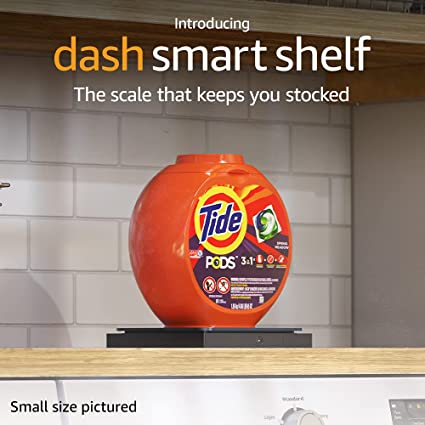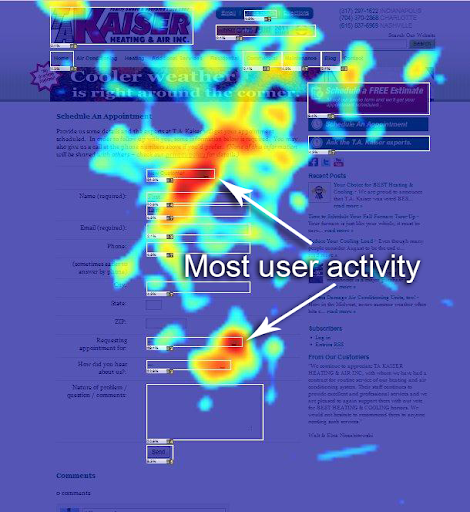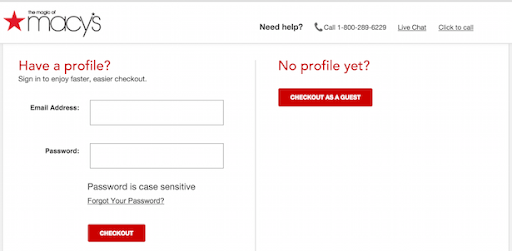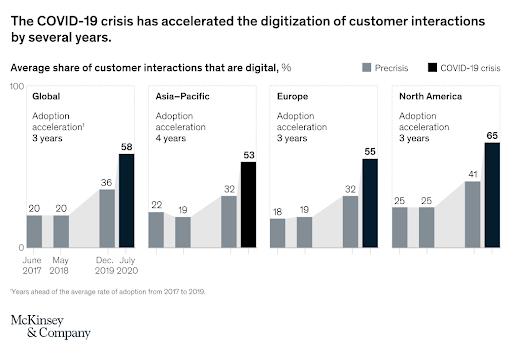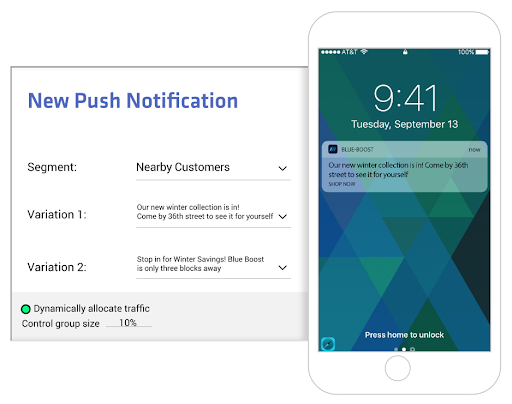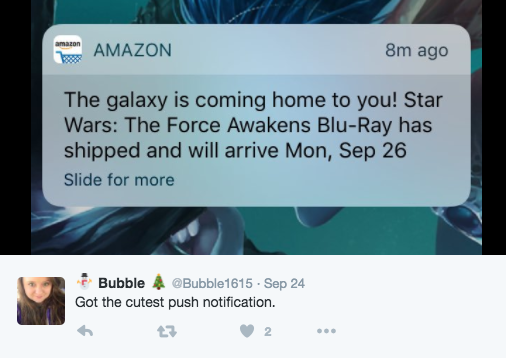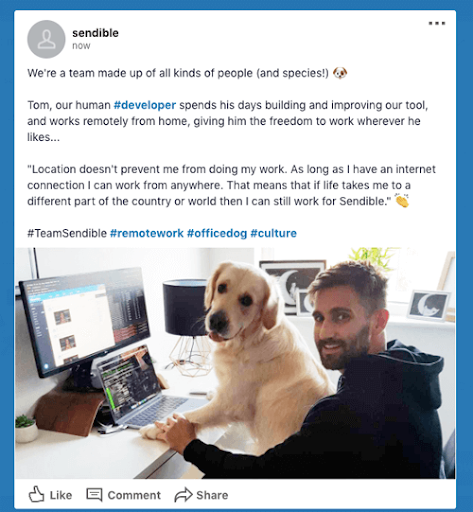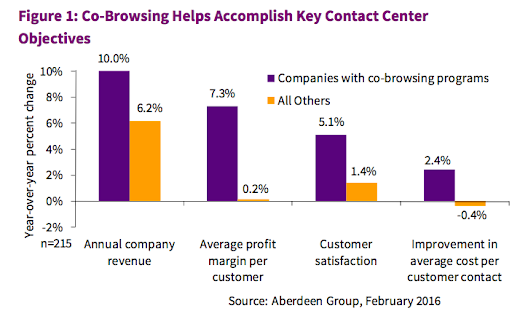Basics of Customer Engagement
Admit it or not, Netflix-binging is a guilty pleasure we all cherish. From light rom-com to murderous thrillers, there is one more thing that we all like about Netflix —It's personalized recommendations.
Allowing people to create profiles and filling their screen with personalized recommendations is just another masterstroke in Netflix's customer engagement strategy.
A company that doesn't strive towards customer engagement is as good as an ice cube out of a refrigerator on a hot summer day; it will eventually disappear.
To understand why engaging customers is a big deal for businesses' sustainability, we must take a deep dive into what customer engagement is, its importance, and what it looks like. Only then will we be able to answer how to measure it and create an excellent strategy for your business.
After reading this exhaustive customer engagement guide, you will find answers to all these questions and more, as each chapter covers a different aspect of customer engagement.
What is Customer Engagement?
Customer engagement is an ongoing process of constant and engaging interaction between a brand and its customers. It's a way to strengthen the company-customer relationship by exhausting and optimizing communication via multiple channels like website, social media, emails, community forums, etc.
If you Google 'What is customer engagement,' we are sure you will come across some sophisticated and complex customer engagement definitions. It doesn't really help understand the concept at large, so here's a brief and straightforward explanation by Paul Greenberg from HubSpot to get on the wagon -
"Customer engagement is the ongoing interactions between company and customer, offered by the company, chosen by the customer."
The process begins from the first interaction and continues throughout the customer journey and as long as they are willing to be your customer. Customer engagement is essential to providing an interactive and excellent customer experience.
Julia Sulonen, Sr. Customer Success Manager at LinkedIn, hits the spot with her idea about the first engagement of a customer with a company—
"If you're having trouble getting customers engaged, churn is creeping up, or you're struggling to meet upsell goals, but only have resources to fix one thing – fix onboarding. If a customer starts off with low engagement, every passing day makes it harder to fix."
Different Types of Customer Engagement
There are four types of customer engagement that you can practice, depending on which type will float your boat.
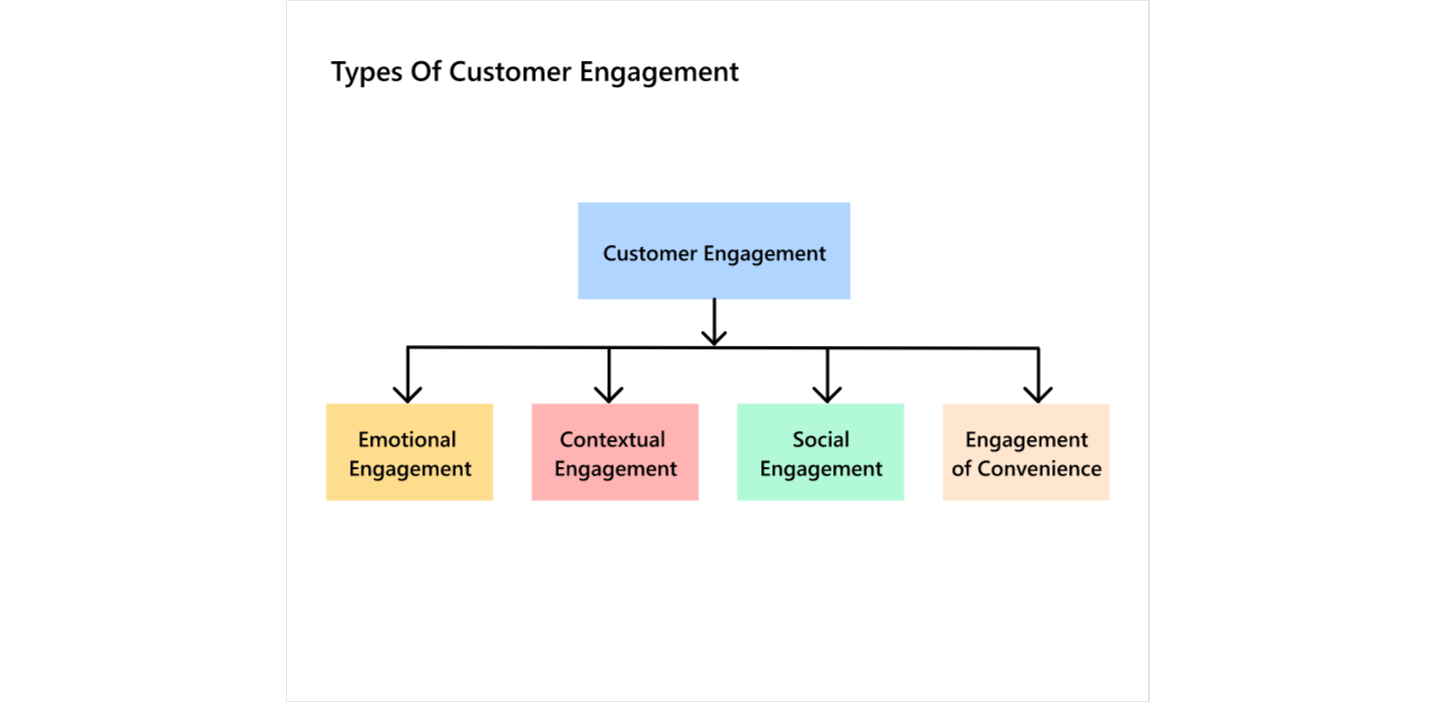
Emotional Engagement
A simple way to explain what the whole notion of emotional engagement stands for is to revisit the words of Carl W. Buechner— "They may forget what you said, but they will never forget how you made them feel."
Companies who successfully imbibe deep into their ideology the value human emotions play in their buying decisions are the ones that can come through the vacuum that is mediocrity. They are the ones that make an impression on customers' minds and keep them engaged for a longer run.
The advertisement below by P&G for Rio 2016 Olympics is an excellent representation of emotional engagement and marketing.
There are multiple ways to approach the customers’ emotional side, from using images and colors, to symbols and ideologies.
Contextual Engagement
Contextual engagement is more about personalizing the experience to promote engagement. Contextual here means understanding the customers' behavior throughout. The marketers can analyze how that behavior relates to your brand and use it to make the engagement more powerful.
For example, brands can refer to the purchase history of individual customers, their location, time of the day, and more to engage them using a number of ways. It could be discounts on the products they checked out, sending them coupons based on their previous purchase, or even sending personalized push notifications to grab their attention to engage with your mobile app.
Social Engagement
Social media has become the backbone of all significant organizations' marketing strategies. From viral marketing to influencer marketing, brands continuously evolve in how they approach and increase customer engagement.
According to Forbes, "62% of millennials say that if a brand engages with them on social networks, they are more likely to become a loyal customer."
Influencer marketing, over the years, has proven to be an asset as it involves people with a community that trusts in their recommendations.
These "influencers" greatly influence people who follow them, and they also want to share the same experience shared by the influencers about brands, their products, and services.
Engagement of Convenience
Instead of just boring you with a theoretical explanation, let's understand this with an example. And what better brand to pick than the one that has become the jack of all trades — Amazon.
Amazon introduced the Dash Smart Shelf that allowed customers to restock supplies. From office supplies to pantry staples, this auto-replenishment scale is able to check the weight of everyday items and notify you if you’re running low or even place a reorder.
There are other start-ups like Replenium, Adrich, and Vectorform that are broadening the application and scope of auto-replenishment. According to Adrich’s CEO Adhithi Aji, “any consumables manufacturer can convert their existing or new products into a connected product” with the services the start-up offers.
Another great example from the same brand is Alexa. Customers with Amazon Prime membership can easily order by only speaking with Alexa. The level of convenience and experience Amazon continually strives to offer keeps the customers coming back to the brand each month, several times.
What Does Customer Engagement Entail?
Customer engagement comes in multiple shapes and sizes. Here are a few examples of how it looks like
- Some customers engage with a brand for its products (for instance, customers buying consumable products)
- Some customers engage because of the brand’s popularity (customers interacting with Tesla founder Elon Musk or Apple enthusiasts engaging with Apple).
- Customers who make a complaint to support. It's also a part of customer engagement and loyalty since they are taking the time to complain and expect improvement.
- Customers who recently purchased a product may comment and spread word-of-mouth on the ad they came across on social media or anonymously review your product on community forums.
- Active participation in the loyalty programs. For example, customers may download your app and collect rewards points and continue to purchase from you.
Customer Engagement vs. Customer Experience vs. Customer Satisfaction: Overlaps and Differences
The customer experience (CX) includes every interaction (direct or indirect) between customers and a company. It includes seeing advertisements on billboards, trains, building, on social media, and whatnot.
From a company's perspective, CX involves putting themselves in customers' shoes and finding ways to make their overall experience with the company remarkable.
On the other hand, customer engagement (CE) is driven by customers as active participants in the process. It deals with understanding how you can engage customers and how they seek to interact with the brand.
Customer satisfaction (CS), on the other hand, overlaps with the CE but is a little different indeed. A customer may be loyal to and satisfied with the company and what it offers but may not necessarily engage much with the brand via their social media or participate in loyalty programs.
On the contrary, a customer may have shopped once but religiously follows the brand on social media and engages in different ways with it.
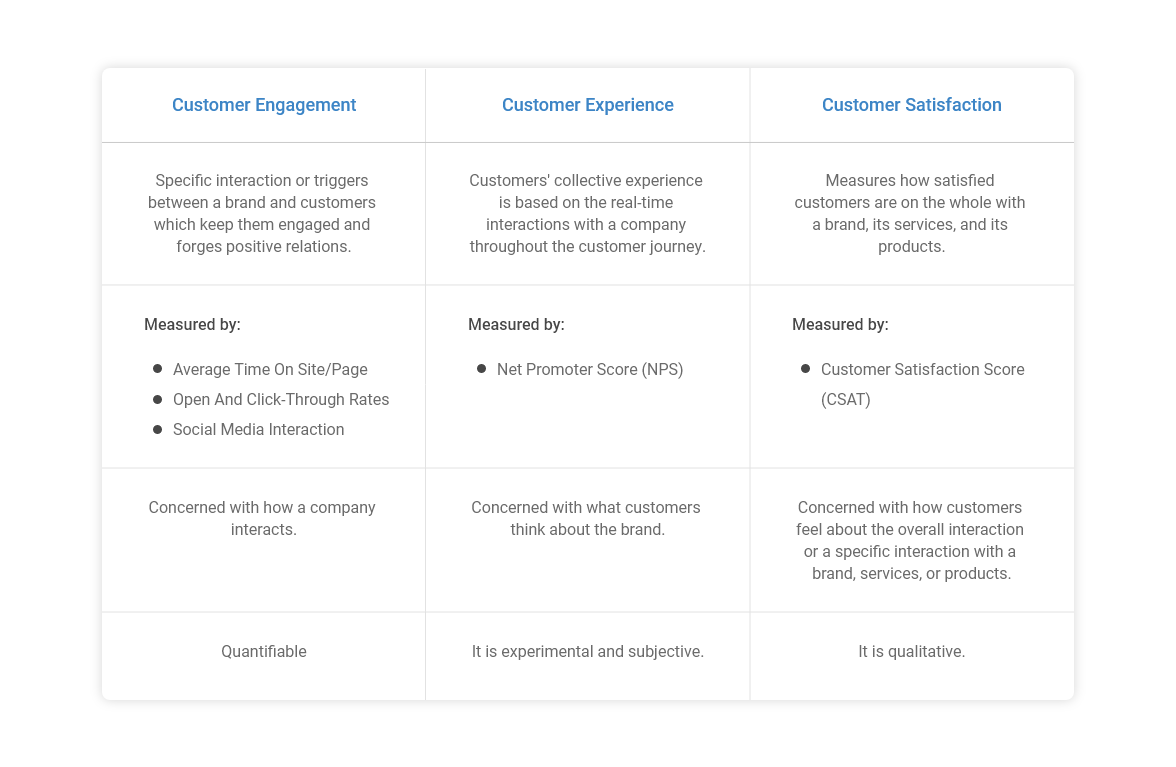
Although customer experience and customer satisfaction are different branches of the same tree, they are very much intertwined and complex. You can refer to our exhaustive article on the customer satisfaction metrics to monitor and explore how measuring customer satisfaction is crucial to understanding customer experience quality and improving it.
Importance of Customer Engagement
This chapter will unravel how businesses cultivate impressive customer experience by working on their customer engagement strategies.
Benefits Businesses Enjoy with Customer Engagement
Increases Loyalty with Good Relationships
Online engagement and marketing are yet to master the quality of interaction that offline engagement offers. Customers could walk into a brick-and-mortar store and be greeted and assisted by sales personnel.
Or think of an independent shop in a small town with one-on-one interaction between the customer and store owner.
Developing an environment online offering this kind of experience inevitably boosts satisfaction and improves relations.
Let's continue the example from the first chapter for Netflix. The brand is proactive with its social media engagement and creates posts and tweets that elicit customer attention and massive responses. The brand actively interacts with the followers by replying in the comment section and keeps the conversation alive.
Netflix on Twitter


Netflix on Instagram
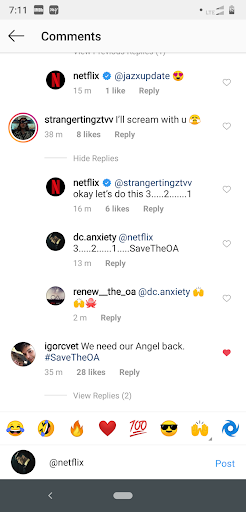
Acts as a Powerful Tool Against Customer Churn
When the customers are constantly engaged with a brand, there is room for educating them about products, services, and other things that can benefit customers and work as a great sales pitch for businesses.
Since customer retention is cheaper than acquiring new customers, the best way to retain them is to keep the engagement alive even after the purchase has been made.
For example, many E-commerce websites send push notifications via mobile apps asking customers to review the products they bought in exchange for reward points.
Many companies engage with customers by asking for feedback using surveys. As a form of engagement, feedback becomes a tool to kill churn.
Personalizes the Cross-Selling and up-Selling Game
Customer engagement campaigns are a smart way to collect customer behavioral insights. This collected data will help you identify behavior patterns in specific demographics for you to create targeted recommendations and with up-selling and cross-selling pitches.
Build Connections with Prospects and Shorten the Purchase Cycle
Engaging with prospects through social media or creating educational content around anticipated queries will allow you to establish yourself as an active entity in their minds.
So, although they might not be your customers today, they will certainly think of your brand when they decide to purchase something similar to your offerings.
Turns Customers into Evangelists
As discussed in emotional engagement, when you consider and appeal to customers' emotions, they develop a sense of brand loyalty and become your true promoters and evangelists.
It is only possible if you promote positive and active engagement, showing that you value them and their feedback.
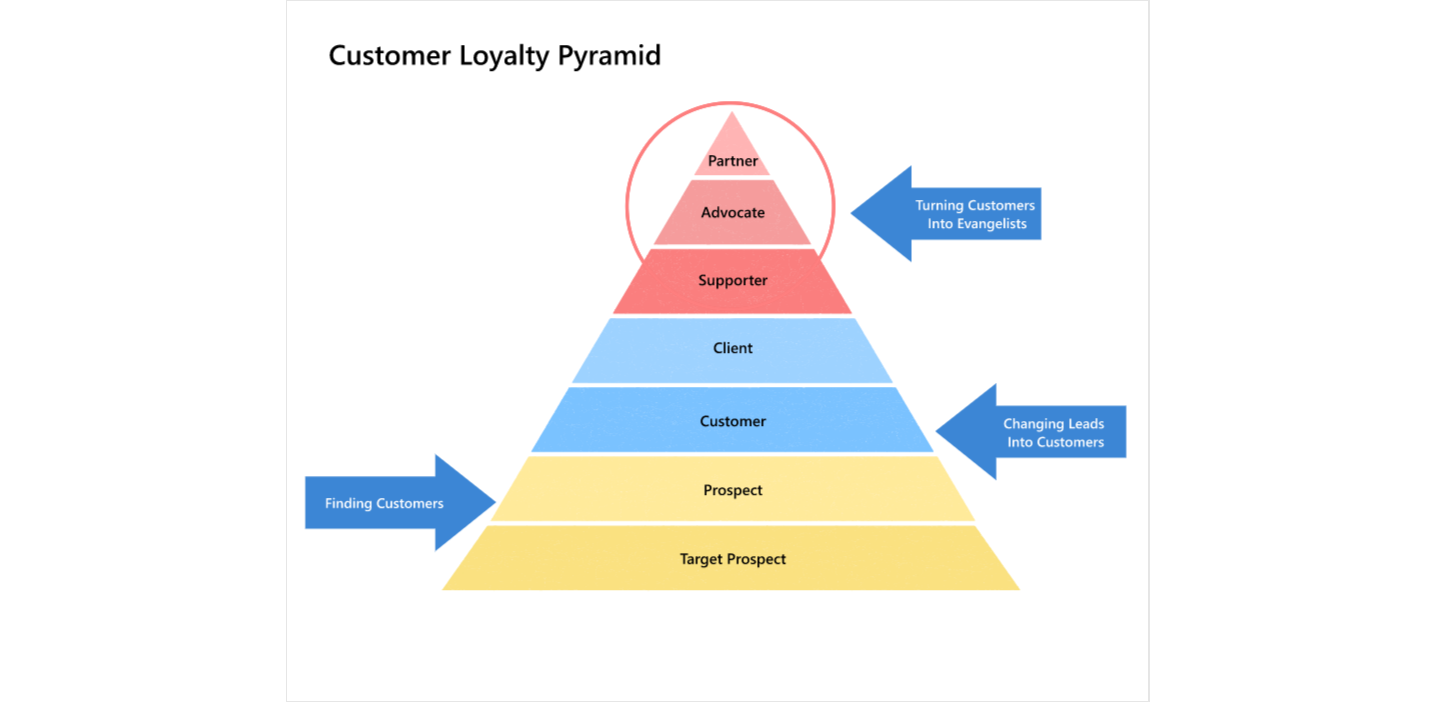
Helps in Distinguishing Brand Identity
An amazing benefit of constantly and proactively engaging with customers is that it helps brands create a separate and impressive business identity.
Your customer engagement strategy should be omnichannel, involving social media, newsletters, to name a few.
An excellent example of personal brand identity is Elon Musk. He takes his customer feedback directly from the source and treats it as a priority. With his direct approach to customer interaction, you can see he has customer satisfaction at heart.
The way he approaches customer engagement and has managed to create a personal brand identity for his business using himself is unconventional and unparalleled.
Increases Customer Spending
It's an obvious yet crucial benefit of customer engagement done right. If customers often see your brand interact positively and be active towards feedback and troubleshooting, they'll immediately consider your company for their buying needs.
Spreads Positive Word-of-Mouth
Once a customer becomes your promoter or loyal towards your brand, drawing from their own incredible experience, they will spread positive word-of-mouth to their acquaintances.
After all, word-of-mouth marketing is the best of its kind so, why not empower your engagement strategy to utilize this marketing approach.
The benefits of customer engagement certainly seem very rewarding but how can you ensure that what you’re doing is right?
You can always analyze how well your customer engagement strategy is performing in terms of turning more customers into promoters using the Net Promoter Score (NPS) metric. You can use NPS surveys and analyze how many of your customers are open to recommending you to their friends and family.
Bonus Read: Best NPS Survey Software & Tools
Measuring Customer Engagement
In this chapter, we will continue to explore beyond the parameters of what customer engagement entails. We will talk about the prerequisites to consider before working towards creating a customer engagement strategy.
Here, we will learn what you need to keep in mind while measuring customer engagement and how to do it. So, let's jump right into it.
Evaluating Customer Engagement: Things to Consider
Be Mindful of the Demographics and Cultural Dynamics
What's more important than creating a robust customer engagement strategy?
Ensuring you have the means to get it right first.
Customer journey maps provide excellent visualization of the larger picture of the user experience, instead of just focusing on one screen or web page. Having this level of context can be helpful when thinking through the more granular aspects of a design (as it gives a better understanding of what users are experiencing and expecting) and the entire user experience you're designing.
You must understand the customer demographics on the basis of customers’ pain points, digital footprints, cultural background, and more, besides the basic ones shown in the image below.
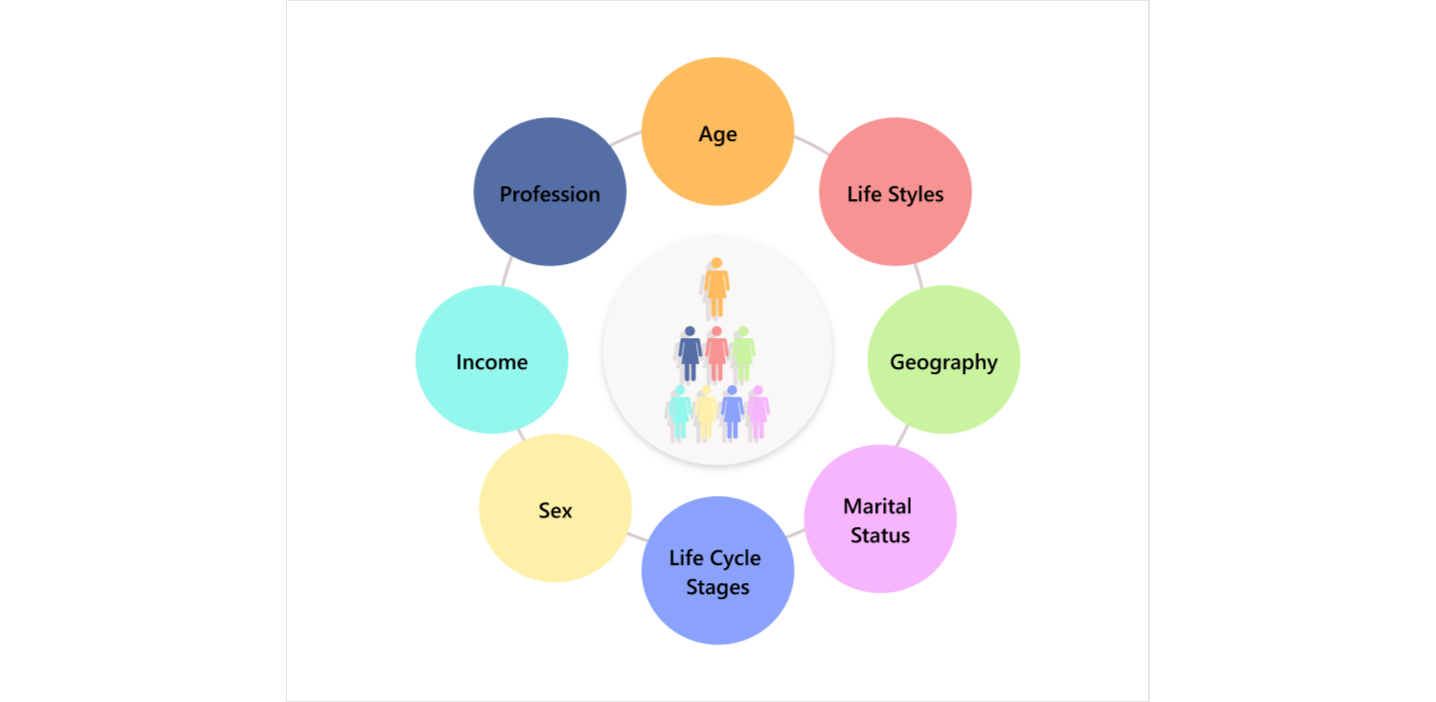
Once you have a good grip of the types of demographics you have and segment it properly, you can develop a targeted and effective strategy to improve customer experience. You can easily influence their buying decisions and keep them engaged.
For instance, depending on different countries, you can send out personalized emails on culturally unique days and give them means and reasons to engage with your brand.
You can also use the demographic data and customer insights using feedback software like Qualaroo to create buyer personas. These buyer personas will help you better understand your customers to innovate more creative engagement strategies.
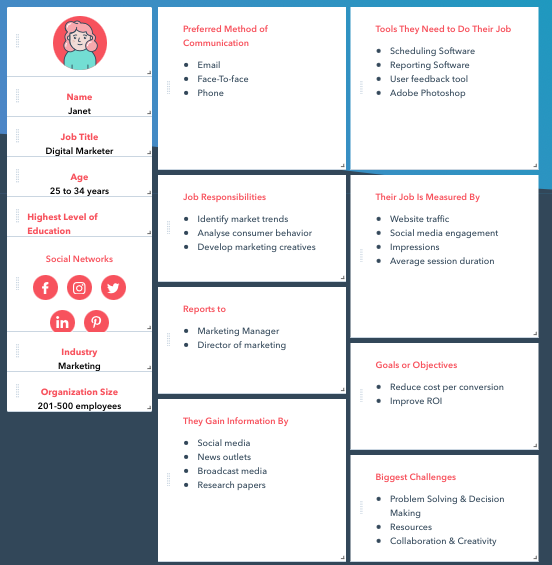
Get a Grip on Your Marketing Methods
Every demographic requires different social media platforms and different kinds of engagement to get the best results. What may suit one demographic may not get the best outcome from the other.
For instance, referral marketing can work for some demographics but certainly not for all. Sometimes viral marketing on social media might be the way to go, and sometimes simply being active on forums and interacting with customers by answering their queries may work wonders.
Keep Your Content Strategy in Place
Content is King...and engagement is Queen.
We know it's a clichè, but it's also true—the content type, the topic, how it's covered speaks volumes for what the brand believes. Figuring out the kind of content that will represent your brand well and resonate with your customers is essential to an effective customer engagement strategy.
For example, sometimes you may want to use rich media to engage customers, while other times, simple educational content is enough to float your boat. You also need to factor in personalization as it promotes a positive customer experience.
9 Ways and Metrics to Measure Customer Engagement
You can use several metrics to calculate the customer engagement rate before and after implementing your customer engagement strategy to see how you perform before and after the implementation.
1. Interaction via Social Media
Remember what we talked about social engagement in chapter 1 and how leveraging social media is a widely practiced trend? You can gauge customer engagement by tracking every day or weekly tweets, likes, replies, comments, and other kinds of interactions on your social media posts.
2. Active Members in the Community Forum
One of the easiest and effective ways to see how you are doing in terms of engagement is to track the number of active members on the community forums. These customers get something valuable from the engagement, so you need to explore what it is and how else you can keep them engaged.
3. Click-Through and Open Rates
Open rate refers to the percentage of emails, push notifications, SMS, messages of messaging platforms opened by the customers.
Click-through rate refers to the percentage of customers who clicked on the CTAs added to those emails and messages.
The higher the click-through and open rates are, the higher the customer engagement rate would be since it means the customers are interested in your offering.
To ensure that the open and click-through rates are high, you should create interesting and attractive subject lines and content for your emails, push notifications, and SMS texts which customers couldn’t help but check out.
4. On-Site/on-Page Average Time
Average time spent on a website or a webpage indicates the amount of time a website visitor spent browsing on it. It becomes apparent that the average time would be more if your website is engaging in its content, user interface, navigation, page speed, etc.
You need to make your website informative and engaging besides offering products and services. Use interactive content and other elements to pique their interest in your brand, so they are motivated to check what else you have to offer and stick around.
You can improve the average time a customer spends on your website by ensuring all the elements on your website are attracting and value-offering to the customers.
Tools like heatmaps, eye tracking, mouse tracking, etc. can help you understand which elements are customers more attracted to and what areas of your website need improvement.
5. Engagement in Referral Programs
Referral programs are a great way to increase customer engagement along with turning casual customers into your promoters. So, it's clear that you need to be creative with your referral marketing strategies to motivate them to refer you to their friends and family.
Active communication also plays a significant role here, as the more they are engaged with the brand, the more likely they are to interact with customer referrals.
6. Repeat Business and Churn Rate
You can track the website traffic and the repeat business you get from the customers to understand whether or not you are successful in engaging your customers. If you offer a positive customer experience, customers will always come back to you for more business.
As for the website traffic, if your social media game is strong, you can divert engagement from those platforms to your website and create an engagement loop.
If you have a SaaS setup or simply a subscription model, you can track your renewal rate/retention rate to see how much repeat business you get. It will tell you if customers want to engage with your brand or not. If your churn rate is high, something is causing a leak in your sales funnel and leading to low engagement.
7. Amount of Filled Surveys
Online surveys and forms are a great way to understand the level of engagement your customers have with your company. The more responses and completed forms there are, the higher the engagement will be.
If you want to take engagement to the next level, you can always try pop-up tools like Picreel that allow you to create exit-intent and other types of pop-ups. You can also use emojis in your surveys to increase engagement.
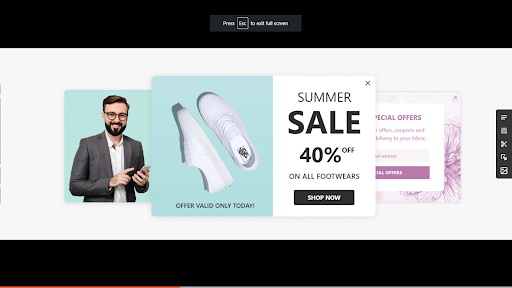
Note: You should provide valuable information and content for customers to be comfortable enough to share their information and interact more with your company.
Bonus Read: Best Online Survey Software & Tools
8. User Feedback via Surveys
Apart from the number of responses on surveys, you need to prioritize the quality of the feedback. Listening to the voice of customers helps you unlock precious insights into your shortcoming and how you can improve the customer experience and engagement as its ripple effect.
You can use survey metrics like Net Promoter Score (NPS), Customer Satisfaction Score (CSAT), exit-intent surveys, and many more to elicit unbiased user feedback.
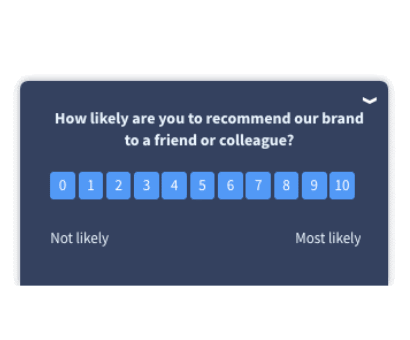
Bonus Read: Best Customer Feedback Software & Tools
9. Guest Checkout Rate
Apart from the subscriptions representing committed customers and repeat business, the guest checkout rate is another way to add to your engagement numbers. People are usually not comfortable signing up with companies or just want a quick one-time buy. Here, guest checkout comes into play.
To create better engagement campaigns, you need to keep track of how many people opt for guest checkout and sign up to understand the kind of experience you gave them.
Customer Engagement Strategy
This chapter is dedicated to explaining everything you must know about customer engagement strategy and how to make an effective one.
What Is a Customer Engagement Strategy?
A customer engagement strategy is a roadmap all companies create to understand what kind of customer engagement any company offers its customers. It greatly reflects customer experience and satisfaction, rendering it crucial to every business's success and survival.
Customer engagement powers organic growth, so it becomes all the more essential to design a fail-proof engagement strategy. Marketing strategy lies partially under customer engagement strategy since it drives engagement at large.
Tips for Creating Effective Customer Engagement Strategy for the Win
Assess and Define the SMART Goals
One of the few first steps you should take when creating your customer engagement strategy is to research.
Assess where you stand and then base your SMART engagement goals on it to compare your progress later, along with defining key metrics you need to be looking for (This is something we already covered in the previous chapter).
Doing this will help you when your business evolves to refer back to your improvements and make or improvise your strategies accordingly.
Define Buyer Personas and Customer Journey
How can you create a robust customer engagement strategy when you don't know how your customers behave and what their preferences, buying habits, and online behavior are like?
Is your customer journey mapped out with necessary touchpoints?
You need to be sure of the answers to these questions to begin creating an engagement strategy. If you haven't already, do proper research to build different buyer personas for your business, along with a clear customer journey and how customers interact with your brand.
To make the job easier, you can use tools like Qualaroo that offer survey templates to gather customer feedback helpful in creating personas.
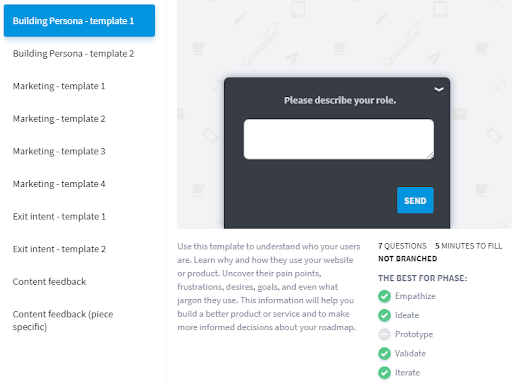
The customer journey map should include every touchpoint from when customers interact with your business via social media, navigate your website, and travel through the conversion funnel. It will help explore opportunities where you can create or improve engagement.
Here's an example of what a customer journey map looks like:
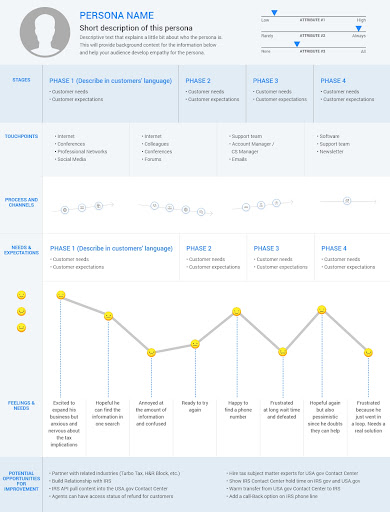
SIDE NOTE* {If you haven't created a customer journey map yet, here are the best customer journey mapping tools you should try to make one.}
Say No to Departmental Silos
Think of departmental silos as beaver-made bridges in a smooth flowing river; they are an obstacle in the way of sharing crucial information from one department to another. Each department of an organization is as important as the other.
A streamlined flow of crucial customer data and insights derived from such data would allow each department to work in sync to ensure your engagement strategy does not fail at any stage in the customer journey and impart a wholesome and positive customer experience.
Departmental silos affect the internal working of a company and are also evident to the customers. This doesn’t work out well for any brand’s reputation.
For example, if someone needs technical assistance, you might as well deploy a subject matter expert for the same instead of making them wait while you connect with multiple representatives.
Embrace Digital Transformation
We all know how COVID-19 accelerated digitization by years. Digital adoption took a quantum leap, making companies and customers realize unique avenues to use technology.
With this drastic digital shift, customers became more engaged with digital e-commerce adoption, and we can see this shift will only become more prominent. So, make sure to stay on this bandwagon and embrace digital adoption for your business to make the most of your marketing strategies to drive engagement online.
Analyze Customer Behavior Across All Channels
To create a successful engagement strategy or improve the existing one, you need to have a deeper understanding of your customers concerning your brand. You need to track their behavior and how they currently interact with you via multiple platforms to see what's causing trouble.
Tools offering session recordings, heatmaps, eye tracking, mouse tracking, and other such features help you closely monitor which parts or content grabs and holds customers' attention the longest and which needs improvement.
SIDE NOTE*
{Check out how you can have the best of both worlds with the Qualaroo+SessionCam integration and keep a closer look at your customers.}
Try the Omnichannel Approach
You need to make an omnichannel strategy to ensure your engagement strategy works out. Although the omnichannel approach consists of targeting multiple channels, you still need an omnichannel strategy to see which channels work best for you and which you should focus more on.
You need to figure out beforehand how you will target each channel and what you expect. It would also help you set up a cohesive personalization flow on all channels for the customers.
Make Personalization Part of the Process
"Find a way to be personal with your customers and connect with them on a human level." — Andrew Reid, Founder of Vision Critical
Personalization can make or break your customer engagement strategy. Since 66% of customers expect brands to understand their unique needs and expectations, it is crucial to consider them while planning your engagement strategy.
There is so much room beyond just using a customer's name to send them SMS or push notifications. You can use the available data points you must have gathered from how they behave on your website, their preferences, previous orders, and browsing history and create wholesome experiences throughout the customer journey.
For one, Spotify does a great job of showing personalized songs and playlists recommendations based on the kind of music users listen to on the app. Another masterstroke customer engagement strategy by the platform was its “Spotify Wrapped 2020” campaign. The platform sent a personalized list to users of their top songs of the year.
Insights-Led Marketing to Boost Engagement
The marketing space is also being colored by the latest technologies to make it more efficient. Marketing technologies (Martech) enable companies to assess campaign analytics to see how the current marketing fares and what needs improvement.
Insights-led marketing and engagement paves the way to more customer-focused campaigns and helps pinpoint critical moments in customers' journeys.
Jason S Bradshaw, the author of It's all about CEX, believes that "Instead of creating desire in a product through aspirational means, customer insight-led marketing is about highlighting how your product solves a problem, reflects or adds to the customer's lifestyle, how it fulfills the expressed and unexpressed needs."
Lead Magnets for Better Customer Relationships
To engage customers, you need to acquire them first, right? It is where lead magnets come in.
Do you still practice the "Subscribe to our newsletter!" thing as your opt-in?
It can't go any more bland than this for customers. You need to up your game and develop exciting and innovative opt-ins that would appeal to customers.
For example, you can share some free valuable information in exchange for their email address. Discounts and coupon code pop-ups were a thing before, but now customers are more value-driven instead of discount-driven.
So, here are a few lead magnet examples that you can use to create better customer relations.
Put case studies in place
Case studies are an incredible medium for providing something valuable to customers for free and working great as an opt-in. These are amazing to show your expertise and that you are aware of their issues and have a solution in place that works for others, so it is fail-proof and legitimate.
For example, Qualaroo offers valuable information through several case studies to show how their solution works and resolves issues.
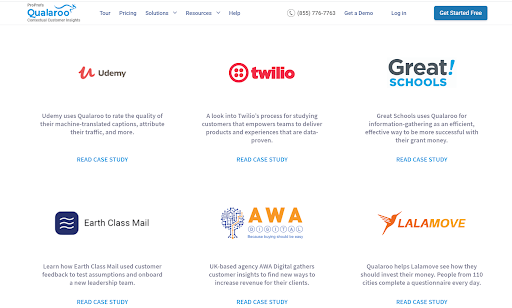
Videos
Using rich media always pays off, and especially videos. Since site visitors or app users love these, search engines also prioritize such content.
Offering auxiliary or product and service-related information through videos increases engagement as customers prefer to see videos over reading long-winded content.
There are many types of videos that you can create to offer dynamic content which customers can engage with and explore more about your brand.
You can create brand videos, testimonial videos, creation videos, and so many more. To help you understand better, here are a few examples of different video types:
Product/service-related videos
Explain a particular product, its features, and services a company may offer. In this example, the video focuses on the pre-designed templates by Qualaroo.
Demo videos
These videos aim to help guide customers on how to use a product.
Educational videos
These videos focus on educating customers about topics related to particular products and services.
How-To Mini Guides and E-books
Guides and e-Books look to offer in-depth information about topics that help customers understand specific topics and how they fit into their business.
Through these guides, you can educate customers on how your products and services play an essential role and why they should give them a try.
Webinar
Again, webinars are highly engaging and are capable of driving leads for many years. You can conduct webinars with industry experts to offer valuable information to customers.
Live webinars are even better as they allow customers to get answers to their queries and real-time. You can upload webinar videos and keep those leads coming in.
Content Marketing
Gone are the days when companies wooed customers with corny punchlines, broadcasting jingles, and other outdated marketing tricks. Since content has taken the lead in marketing, companies have become smart in using content for marketing.
From blogs, infographics, PPTs to e-books and webinars, you can promote any of these contents as long as they are valuable to the customers and represent the brand voice.
Visual content and videos, specifically, are the aces of content marketing. Customers enjoy videos as informative content and instead prefer it more than written words.
The fact that 90% of the transmitted information to the brain is visual and that it processes images 60,000 faster than the text is reason enough to focus more on making creative, authentic, and insightful video content to use for content marketing which will eventually gather engagement.
Joint Ventures/Collaborations
There is so much you can do in terms of collaborations or deals. You can try product partnership if it's something that suits your business type, a sponsorship deal, joint venture with other businesses, or simply collaborate in webinars.
These collaborations and joint ventures give you exposure to new prospects and even highlight your strong points and expertise.
It's a great engagement strategy as customers from the other business will be interested in checking your company if what you offer in these deals and sponsorships is genuine and valuable.
Introduce Self-Service
Another great trick to add to your customer engagement strategy is introducing self-service. If you want to increase customer engagement, then you need to make them independent in interacting with you.
You can implement a knowledge base so that customers can engage with your brand more directly and in real-time. They can resolve their queries without being dependent on support. So, you are actually killing two birds with one stone here.
Implement Augmented Reality (AR)
As technology advances, so do the expectations of customers from companies. When next-gen technologies like Augmented Reality are gaining momentum, it's about time you also get on the bandwagon.
AR technology allows so much room for innovation where you can find different ways to engage your customers.
It adds virtual elements to the physical world so you can make some pretty interesting things to keep the engagement alive. Many e-Commerce businesses implement AR to help people pick the best products by personalizing the experience.
Here's an example:
One of Qualaroo's clients, ART.com, uses AR technology to help people buy art online by allowing them to virtually picture how and where the art would look good in their home.
NOTE*
{If you want to know how Qualaroo helped Art.com gather insightful feedback, then refer to this detailed case study.}
Use 3D viewers
Specific to e-commerce, 3D viewers allow customers to have the same satisfying experience online as they do in a brick-and-mortar store. They provide a 3D and 360-degree view of products to help them choose the best fit. It not only improves customer engagement but works wonders for the overall customer experience.
Watch: 360 Product Viewer for Ecommerce
The Era of Interactive Videos
It's the time for interactive everything, from interactive websites, mobile apps, surveys, images to now video as well. Irrespective of the industry or what kind of business you own, there is a lot of creative space available to put something unique out there, representing your brand using interactive videos.
Here is an example of a Jaguar-sponsored advertisement of Colophon Foundry. You can check out profiles of people that appear in the video at several points during the advertisement.
Leverage Artificial Intelligence to Personalize Marketing
Personalization again comes into play as a significant way to make all your strategies from marketing to engagement a hit. Earlier, due to the lack of adequate data analysis tools, all the customer behavior-centric data was not utilized in the marketing space, but the tables have turned now.
Many Artificial Intelligence (AI) tools make this job a lot easier and expedite the analysis process, giving invaluable insights from large data chunks to deeply understand customers' desires (expressed or otherwise).
Using these insights to command your marketing strategies makes the experience more personalized for customers, driving customer engagement inevitably.
Identifying Channels to Drive Customer Engagement
In the previous chapter, we covered in detail what helps you make a fail-proof customer engagement strategy. Now, this chapter is a continuation of our journey into the channels that drive customer engagement.
How to Drive Customer Engagement Through Various Channels
Owned Websites and Mobile Apps
In this day and age, when going digital for business is more of a necessity than a choice, owning digital properties like websites and mobile app (s) is pivotal for survival. Otherwise, how else would you drive customer engagement? Besides, these are a great source to offer personalization and contribute to the majority of customer experience, your brand messaging, UI/UX, and everything else.
That's why you need to ensure you do everything right with your websites and mobile apps to ensure your engagement strategy has a chance to bring in great results.
One of the effective ways to know where all you need to improve the overall CX is to use on-site and in-app surveys to collect in-context feedback that is way more valuable than email surveys.
For instance, you can take feedback on specific content pieces to gauge what content customers need.
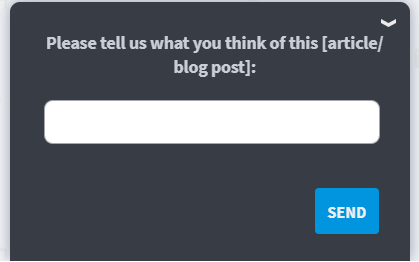
For this, make sure you include interactive elements throughout your website, offer relevant, unique, and informative content in the form of blogs, guides, e-book, product pages, and more. Keep personalization in mind at every touchpoint and offer incentives to promote interaction and engagement.
Bonus Read: 11 Best Mobile In-App Feedback Tools
Old but Gold Emails
Emails are old but gold, as they are still a relevant marketing tactic that can add to customer engagement.
You can employ different types of emails: newsletters, Thank you emails, welcome/signup emails, abandonment and recovery emails, transactional emails, new product emails, service launch emails, and survey emails.
To ensure you are able to utilize this channel fully, here are a few tips up our sleeves that might help:
- Make the emails mobile-friendly.
- Use creative subject lines to motivate people to open the emails.
- Add interactive elements, make the copy informative and valuable with useful resources, etc.
- Don't sound promotional from the get-go.
- Develop trust via social proof and success stories from customers.
Push Notifications
Time and again, push notifications have come forward as a great marketing channel to bring engagement to company platforms. Now, it can be fruitful only if customers click on your web and mobile push notifications, and that's where the challenge lies.
Again, you need to make the heading and sub-heading of the push notifications not just attractive but something that customers cannot resist.
Here again, personalization plays an important role not just as something you can do by mentioning customers' names but also taking the data points about them (such as their address) and using them in your copy.
Besides using them for promotional messages, you can occasionally use them to push updates about newly added content, updates, trends, deals, loyalty programs, and so on.
To make push notifications even more pragmatic, you should segment the customer lists to send targeted notifications based on their location, time when they are most active, and more.
Live Chat
One of the obvious ones is the live chat feature. Over the years, we have been reading about how live chat, be it with humans or chatbots, has become one of the necessities for businesses since 92% of customers prefer live chat over some other channels.
Now, you can leverage live chat in so many ways besides using it for real-time troubleshooting. For example, it can help improve engagement metrics. You can target revisiting customers with personalized recommendations or offer helpful resources as solutions to divert the traffic to other site pages.

Social Media
Another of the obvious channels is social media. With the never-dying hype that social media platforms offer, it is mandatory and natural to target them. With interactive images on Instagram to clickable links on Facebook, these channels have so much potential to sky-rocket your customer engagement
SMS Messaging
It's hard for technologies as old as SMS from the early 90s to stay relevant still in companies' marketing strategies. People still engage with text SMS messages from brands they are interested in, so you might as well make the most out of it.
There are other ways you can increase customer engagement using SMS messages:
- You can offer valuable information to the customers like reward points, send reminders about events or abandoned carts, etc.
- You can also let them reply to take some action like canceling or confirming orders as a means of interacting with them.
Voice Assistants
Carrying forward what we discussed under 'Engagement of Convenience' in chapter 1, voice assistants are making conversational marketing viral worldwide. Google Assistant, Amazon Echo, and Apple Siri are just a few examples of AI-powered voice technology that allows customers to achieve goals or perform specific actions using voice commands.
It is a great engagement source since customers engage verbally with the brand itself, which is much more convenient and effective than typing.
Uncovering Customer Engagement Best practices
This chapter entails how you can increase customer engagement and how it looks for each stage in a customer journey.
Ways to Push Customer Engagement for Your Business
Design Content Marketing Strategy That's Consumer-Centric
The words of Tom Fishburne, "The best marketing doesn't feel like marketing," truly represent what marketing should be and how customers see it. That's true even in the case of content marketing.
The crucial thing here is the relevance and usefulness of the content you create for the users, which also resonates with your brand voice. Content plays a huge role in making your inbound marketing successful.
To get your marketing strategy right, you need to be strategic about your content with respect to the following:
- What you create
- Who you create it for
- For which channel you create it
- How you market it to drive engagement
Gamification
Gamification is not new, but it gained a lot of attention and momentum in recent years. It makes the interaction with the company fun and more engaging. Companies invent marketing campaigns using gamification and encourage people to participate.
It may consist of a brand asking customers to take screenshots from a GIF of a particular scene, and whoever gets it will become part of a loyalty program or win a reward.
Some brands introduce quizzes on their website to test customers on their knowledge about certain topics and create gated resources based on the responses from the quizzes. Some e-commerce businesses employ games like fortune wheels to give discounts, vouchers, and coupons as rewards.
Prioritize Customer Feedback
Customer feedback gives you insights that you cannot find in any other data. Hearing straight from your customers gives you unfiltered, unbiased, in-context, and actionable feedback that can help you improve in the areas you are lacking.
To hear what customers have to say, companies use survey & feedback tools like Qualaroo to launch on-site and in-app surveys and gather insights from customers or do a quick pulse check. The platform also guides you on how to ask the right questions from the customers to get the feedback you need.
SIDE NOTE*
{Check out what questions to ask in a website survey to collect valuable responses.}
Humanize Your Brand and Your Interaction
Breaking apart from the 90s notion of how a company approached its users, bringing back the human touch to the business is gaining momentum. Instead of treating a company as a business alone, customers want to see companies' human side to relate more easily.
For example, Elon Musk here is an excellent example. It's remarkable how people think of Elon Musk first whenever they hear Tesla and how it's his work. It creates a more profound impression in the customers' minds, and they immediately start relating to the company. Of course, this is a very simple example of humanizing a company, as there is so much more to it.
Companies have started to share their company culture to showcase their workforce or rather the 'humans' of the company. Apart from this, generally interacting with your customers on social media directly also makes them see how the company actively interacts personally.
Acknowledge Your Active Clients and Promoters
If you are blessed to have customers who actively engage with your brand, you need to acknowledge this engagement source and do something about it. Consistent engagement with such users keeps them aware of your offerings. A little bit of nurturing of this relationship on the company's part can make loyal customers out of these active customers.
You can create special loyalty programs that give them exclusive early access to some of your products or services. Doing this impresses them and increases the chances of positive word-of-mouth marketing.
Another great example is e-Commerce websites that create services and products limited to exclusive customers like Amazon's Prime, premium memberships, or simply giving reward points on every penny your customers spend like Starbucks.
Create Customer Engagement Campaigns for Each Lifecycle Stage
To give you a clearer view, let's talk briefly about how you can boost engagement at each stage of the customer lifecycle to create a well-defined and cohesive customer engagement loop.
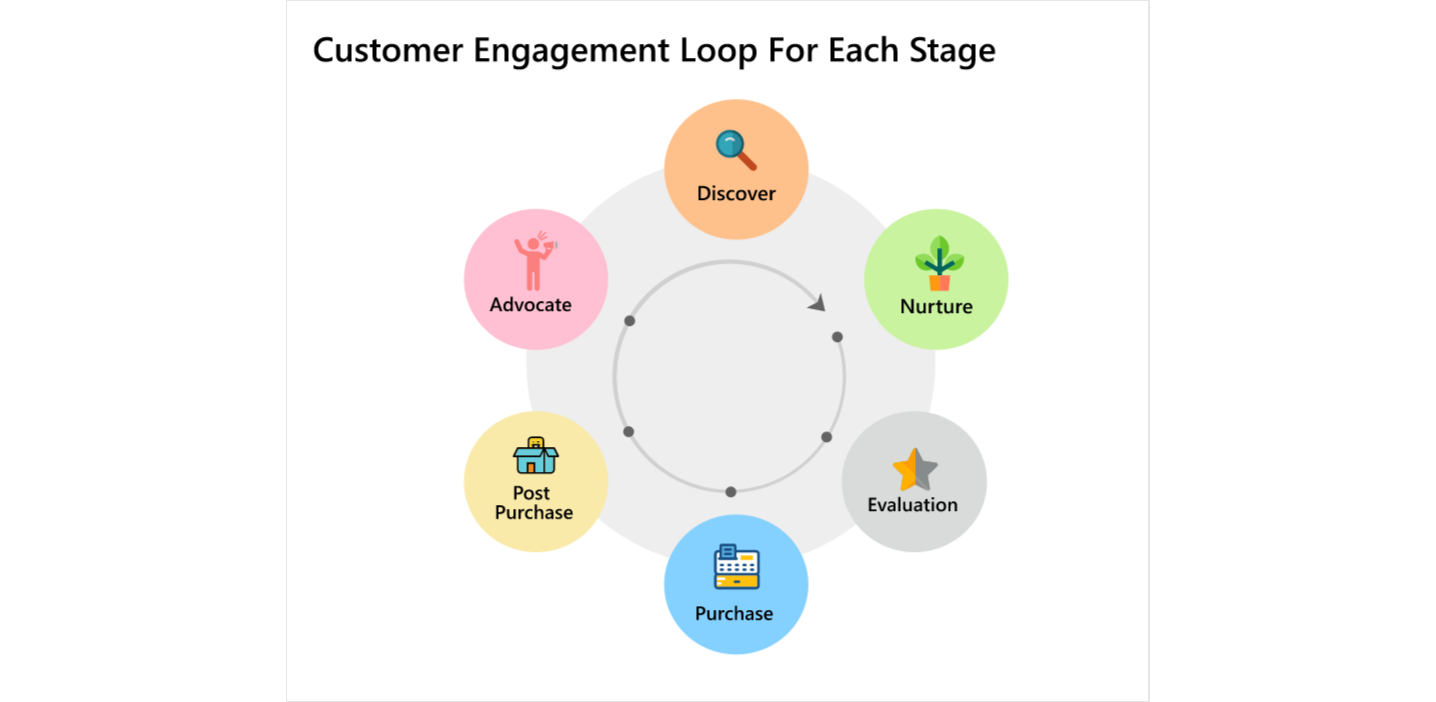
Stage 1: Discover
It is the first stage where your prospects interact with your brand for the first time in any way and become aware of your business. At this point, they may follow you on social media or browse through to see the type and quality of content you offer.
It is the time where they judge and explore a business and decide whether or not they want to be a part of your email list.
To ensure you can turn your prospects into customers, you need to offer refined and educational content that would grab their attention and make your brand seem relevant to their needs. Use all of your channels to market content that intrigues prospects and makes them stick.
One way you can do this is by conducting surveys to find out what type of content customers would like to see from you.
For example, retail businesses can create content around:
- how certain products are used,
- innovative ways to use them,
- benefits customers get from products,
- emphasizing what the brand believes in and more.
SaaS businesses can create content around their services and educate customers about the industry and what else they can do to improve their business with their services using infographics, blogs, social media posts, and many types of videos which we covered in chapter 4.
Stage 2: Nurture
It is the second stage in their buying lifecycle, where they show interest in the brand and sign up for your email list. Although, it would still take a while for them to become a buyer.
The best way to boost engagement is to use the information you get from email and personalization in email marketing.
For example, you can show them personalized recommendations based on what they checked out on your website or send promo code via SMS messaging to invoke their curiosity to check out where they can use it.
In order to ensure they purchase from you, it is plausible to implement re-engagement marketing campaigns after a while for their actions.
Stage 3: Evaluation
Here your prospects are seriously considering purchasing since they have either watched product-related videos and such content or added items to their cart (in case of e-Commerce). You need to make sure you do not lose them at this point.
For this, you can push web or mobile push notifications with relevant offers and deals that will push them towards a successful checkout. Make sure to personalize the notifications and such triggers to make them impactful.
Stage 4: Purchase
For example, SaaS companies can welcome customers with pleasant messaging and make the customer experience even more impactful using multi-channel onboarding. They can use an email with product-related information and what they could expect from their purchase. You need to go beyond the transactional emails and add the touch of personalization using their demographic, buying preferences, and more.
In-app messages and onboarding videos on the website are other ways to achieve multi-channel onboarding. One thing to ensure is your multi-channel onboarding should be cohesive and seem like a part of the larger narrative of the company.
Stage 5: Post-Purchase
In e-Commerce companies, a simple 'Thank you for the purchase' message with a few product recommendations based on customers’ orders is the way to maintain engagement.
You can also use a multi-channel approach and advertise product recommendations based on customers’ last purchase, send push notifications about new products and deals, or something valuable and related to their purchase. You should observe user behavior and target the platforms on which users generally engage with your brand to focus your post-purchase engagement strategy there.
Stage 6: Advocate
It's time to focus on keeping the engagement alive after the purchase is complete. If your customers cannot feel a connection with your brand, they aren't likely to return. To ensure they are hooked on you, loyalty programs are a great way to motivate customers to keep interacting with your business.
You can segment and then track customers' interaction with your company at every touchpoint and design suitable loyalty and reward programs. It also helps with word-of-mouth marketing.
Customer Engagement Platforms
In the previous chapters, we covered everything from what customer engagement means to how you can boost it for each lifecycle stage. So, following the same flow, we will now look at customer engagement platforms that you can employ in your engagement strategy.
That said, let's have a quick look at what customer engagement platforms are, to begin with.
What Are Customer Engagement Platforms?
Customer engagement platforms are tool stacks of multiple software that help acquire and engage customers and offer customer satisfaction and experience across all communication channels.
Each platform offers something unique and essential to the engagement strategy. They help centralize your interactions with customers.
They help companies:
- see the bottom-line growth.
- get a competitive advantage.
- centralize the communication with customers.
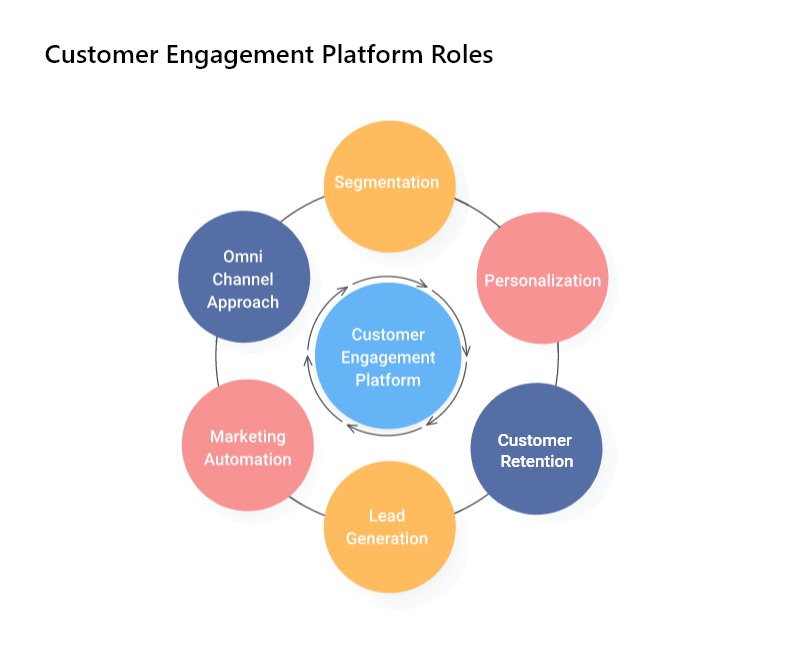
Tools to Drive Customer Engagement
Here are some tools that ensure your carefully created customer engagement strategy makes an impact.
Social Media Platforms
Social media platforms are great tools to drive customer engagement in large numbers. Facebook, Twitter, Linkedin, Instagram, Pinterest, and Reddit are social media channels that brands actively engage in and launch marketing campaigns.
These platforms allow companies to create communities and keep the conversation going between both parties.
Online Surveys
Online surveys help companies in multiple ways. For starters, they prompt engagement with customers by asking them for their feedback. Secondly, they allow companies to tap into their users' minds, gauge what they desire and build engagement strategies around these data points. It's a great source of data that helps personalize the customer experience and engagement strategy.
Tools like Qualaroo offer on-site and in-app feedback surveys. Its pop-up NudgeTM technology is excellent for gathering feedback from customers without disrupting their customer experience.
You can also engage your loyal users in helping you test prototypes. You can embed feedback surveys in the prototype of your product and learn what needs improvement from customers themselves.
You can also add CTAs to your surveys to direct the customers towards relevant web pages. For instance, you can create surveys with branching and skip logic. Suppose you asked on your homepage or your product page -
"Which of the following do you need help with?"
- Product information
- Pricing
- Returns/Cancellations
Here, if customers choose 'Product information,' you can add CTA to your knowledge base in the next step so they can navigate there.
Bonus Read: Best Online Survey Software & Tools
CASE STUDY
GoodBlogs
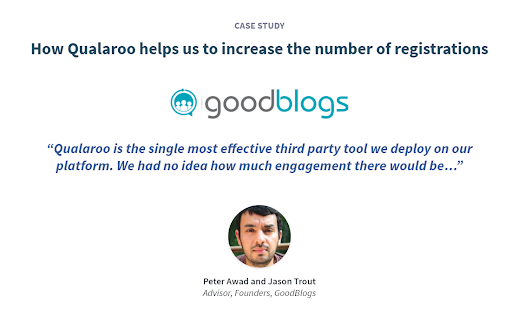
GoodBlogs platform offers a licensed crowd-sourced content creation platform to its clients. It rewards user-generated content, mainly blog posts, leading to large amounts of niche-specific traffic from search engines and social media channels.
According to Peter Awad, "We wanted to figure out the best way of turning all of this targeted traffic generated by our platform into hard ROI for our customers via lead generation, so we implemented Qualaroo."
GoodBlogs uses Qualaroo surveys to ask customers what topic they would like to read. Based on the response, readers are led to a funnel with relevant blogs and encouraged to sign up to the email lists.
Co-Browsing
Co-browsing is just what it sounds like. It allows companies to offer interactive support services to customers and enhance their customer experience. It is most helpful during the time of troubleshooting and onboarding new customers.
It eliminates the inconvenience and time taken in explaining things over the phone. Support representatives can access customers' screens and even interact with the screen remotely with permission from customers, of course.
Chatbots
Chatbots are another great tool to ensure your customers can engage with your company whenever they want some issues resolved. These allow companies to offer real-time help that is effective for customers and the company since they need fewer human resources for support.
Customers can seek support 24X7 and 365 days, which improves the customer experience. Chatbots also increase engagement since they can shoot relevant surveys or personalized recommendations to resolve queries.
A/B Testing
It's always advised to A/B test not just your products but your strategies as well. A/B testing allows you to test anything in two parts - part A and Part B with only one specific element changed at a time to see which version performs better.
You can do the same with your customer engagement strategy. You can try different things simultaneously on different customer segments and finalize the one that brings in more engagement. A/B testing is an ongoing process, so it will help you explore and improve your strategies which is a good practice.
SIDE NOTE*
You can refer to this guide on 30 Best A/B Testing Tools to Help You Convert in 2023
Knowledge Base
We touched upon this lightly in chapter 4 how self-service is gaining momentum and customers don't want to wait on phones or support. They want to take matters into their own hands and resolve generic issues they might have using the company's knowledge base.
With an effective knowledge base, customers can access any content from guides, e-Books to helpful FAQs the company has ever created. It saves them the hassle of looking for the content on other browsers, which is time-consuming and inconvenient.
{Wondering which knowledge base will offer the best experience to your customers? Choose your pick from these 11 best knowledge base software.}
B2B vs. B2C Customer Engagement Differences and Common Denominators
There are two prominent types of businesses — Business-to-Business known as B2B and Business-to-Customer known as B2C.
Both these business types work differently, with a few overlapping similarities. Because the processes and business model differ, how you design and implement marketing strategy, content marketing strategy, customer experience strategy, and customer engagement strategy varies widely.
Differences
Success Metrics
Success metrics differ significantly for both B2B and B2C businesses. For example, for B2B, metrics like churn rate, dollar retention rate (DRR), and CTRs across all marketing channels are paramount.
Whereas, in the case of B2C, metrics are highly dynamic and subjective. It includes every interaction on social media such as likes, comments, shares, bookmarks, story updates on Instagram, loyalty, referrals, etc.
Communication Channels
A multi-channel approach is standard for marketing activities these days. Many B2B companies are still heavily reliant on paid and email marketing. Apart from this, a fraction of their marketing strategy consists of channels like Twitter, Linkedin, and Facebook primarily, with other optional social media.
For B2C, it is more omnichannel than multi-channel since customers want a more continuous interaction with surprises at all touchpoints.
Content
Content holds the priority for both types of businesses, but there are still some differences in how each approaches it. For B2B, the traditional long-form content is still valuable. Customers do look forward to checking out guides, e-Books, and thought-leadership type blogs. They are treated more as assets than just a medium to drive website traffic.
When it comes to B2C, it is more dynamic and adaptive to the demands of customers as customers always expect something new and intriguing. Because the attention span is literally in seconds, B2C companies had to up their game and create content pieces that stand out from the rest. Video and short-form content are highly in trend and bring outstanding results.
Factors That Drive Sales
B2B sales cycle is comparatively longer than that of B2C. Moreover, since B2B products are for businesses with specific needs, the sales experts must have a thorough knowledge of the product/services from both a business perspective and some technical knowledge about the features. They need to engage as well as educate customers and make conversations that translate into leads.
On the contrary, B2C sales depend on the brand image and the pricing of the products. Some customers might purchase products from a brand they like, even if it means paying more.
It may be because the company offers excellent loyalty programs, the brand believes in something, or supports a cause that resonates with the customer. It is not the case with B2B, as pricing and functionality are two main deciding factors.
Common Denominators
Customer Service
Customer service for both B2B and B2C requires comprehensive knowledge of products or services. The sales personnel deals with the customers who are high-level executives in the respective companies, whereas B2C supports direct communication with the customers. In both cases, the primary goal is turning leads into customers.
Knowledgeable Customers
In both industries, the customers are more aware of the products they want to buy and their precise needs. They do their homework and look for better alternatives to get the best deal. It's more than just wooing customers with an attractive copy that offers little value. Now, companies are being pushed to be more genuine and transparent.
Customer Engagement Stages and Use Cases
Let's look at a few industry giants that understood what customer engagement should be like and are killing it in the game. Learn from the best to get the best results.
Excellent Customer Engagement Examples to Look up To
Furniture retail giant IKEA is known to be one of the early adopters of different technologies. The brand constantly strives to ease the buying process and make the experience comfortable.
Gillian Drakeford, the Country Manager for UK and Ireland, explains that "people want human interaction… it's what we've always done, but it's enhanced by technology and expertise."
The brand successfully brought the in-store experience online using video chat and Augmented Reality (AR). Customers can use IKEA's AR app and see its online catalog to see how it fits in their home and make informed decisions as they would in-store.
Starbucks is known to bring new things to the table that just make people want to engage with the brand. Starbucks took an offline approach to customer engagement which customers fully supported. Its initiative known as Starbucks Reserve Roasteries would allow people to see first-hand how Starbucks brews its coffee in specific locations worldwide.
It successfully created a big buzz, and customers would come to check it out while ordering a coffee or two. Customers could also taste the different types of coffee and have conversations with coffee specialists. It helps create an immersive coffee as well as a retail experience for customers.
Coke used the best of both worlds - online and offline engagement with its #ShareACoke marketing campaign.
Under this engagement scheme, coke exchanged its icon logo for 250 names of people, which are common. This level of personalized marketing attracted many customers, and they started to buy a coke for their friends and family members having those names or for themselves with their names and share on social media platforms with the hashtag.
Steps to Create an Effective Customer Engagement Strategy
These steps help create a cohesive and streamlined customer engagement strategy that optimizes engagement at each stage. Let's check out what they are:
Step 1- Preparation
At this stage, you need to evaluate your current situation, set SMART engagement goals, create customer personas, map out the customer journey, and design a business case.
Step 2- Planning
At the planning stage, you need to keep these things in mind -
- Perform market/competitor research
- Choose strategies and tactics that suit your business model
- Design rollout and budget plans
- Don't forget to align teams and operations for a streamlined process
Step 3- Implementation
Implementation of your customer engagement strategy is the third step in the process. The key defining areas of this step are -
- Assess technologies like sending RFPs
- Select suitable providers
- Efficiently launch systems and plans
- Refine your strategy to make it as fool-proof as you can for incredible results.
Step 4 - Tracking
After successfully implementing your customer engagement strategy, it's time to track your progress and see the improvement you made.
Here, you need to report on KPIs and metrics, collect feedback from your customers to find areas to improve, A/B test and experiment with your existing strategy to develop innovative engagement ideas, and keep an eye out for digital engagement trends to keep your strategy up-to-date.
Future of Customer Engagement
Customer engagement is a common denominator between customer satisfaction and any company's success.
You need to come up with unique ideas to design your custom customer engagement strategy and see your business become the Netflix of your industry.
Something like this is only possible when you know what's to come in a few years in the customer engagement space. It is to make the shift seamless so you can enjoy the effective adoption of new trends.
In a podcast titled, "The Future of Customer Engagement and Experience," hosted by Steven Spears in partnership with FCEE, he talks about the anticipated and unanticipated trends that will arise in the CX space.
One trend that they talk about is "Headless Commerce." The aim to improve customer experience is to feel instant, fresh, and engaging, and headless commerce promises to deliver all three of these elements.
In simple words, "headless commerce is essentially the separation of a storefront website from a commerce platform that powers experiences itself." It is targeted more towards the Internet of Things (IoT) age. It refers to decoupling the frontend (user interface) of your website from the backend.
The headless commerce architecture offers a platform using RESTful API, which only has a backend model and a cloud infrastructure.
It allows web apps to load faster and provide a seamless experience. It is easy to make changes to the frontend without the help of developers or making any changes to the backend.
In the podcast, the guest speaker states that,
"...It is a good investment to do...that separation really simplifies and accelerates the pace at which you can innovate experiences. It might be a bit painful to move out of your existing storefront into something that is headless. But doing it is gonna provide you a really big boost and agility because you got a lot less things to move when you want to make changes and improve it. It reduces the number of dependencies on other teams, for sure. "
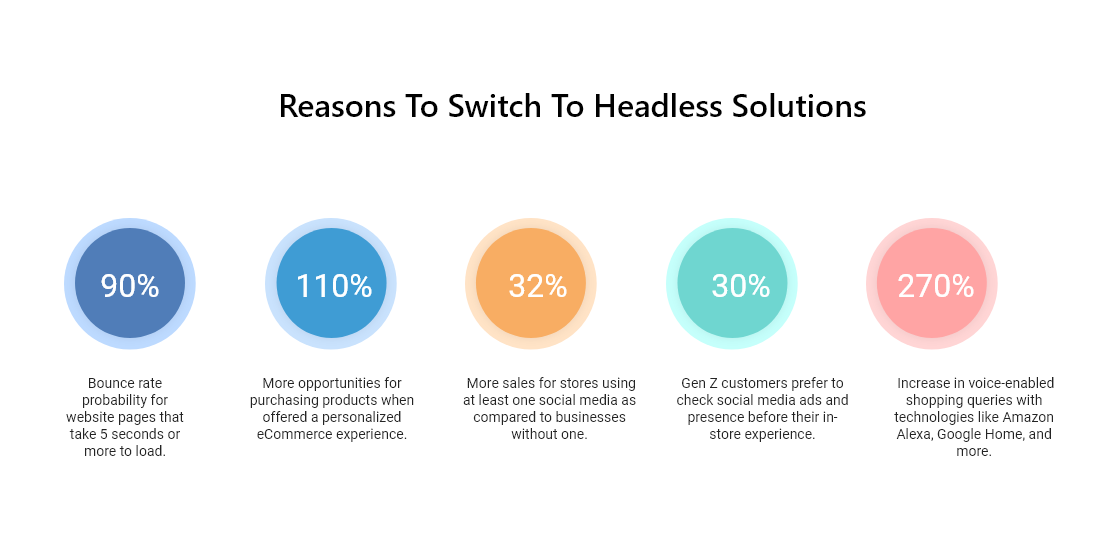
It boils down to the fact that your business should evaluate and keep innovating its plans and strategies to align with the trends that ensure steady growth.
With this, we conclude our extensive guide on customer engagement and what goes into building a robust engagement strategy. To sum up, you need to properly understand what customer engagement is and then incorporate headless commerce, opt for approaches like omnichannel, multichannel, create engaging content, intuitive digital properties, and listen to the voice of customers to boost customer engagement.
Remember, everything that you add to your engagement strategy should flow cohesively to create an incredible customer experience that largely promotes customer engagement.
Frequently Asked Questions
What is the role of customer engagement?
Customer engagement ensures that your customers are aware of new updates in your services and products and keep interacting with your brand, strengthening the relationship and turning prospects into customers.
What is the customer engagement process?
The customer engagement process starts with preparation for creating the strategy, then comes the planning where businesses create buyer personas and customer journey maps. Next is the implementation stage, where the strategy is implemented and tested to ensure its working effectively. The last step of the process comprises tracking the progress made with the strategy by analyzing some customer engagement metrics.
What are the five levels of customer engagement?
The five levels of customer engagement are Discover, Shop, Buy, Own, and Advocate.
Want to know what your customers think?
Qualaroo is the world's top customer feedback tool
